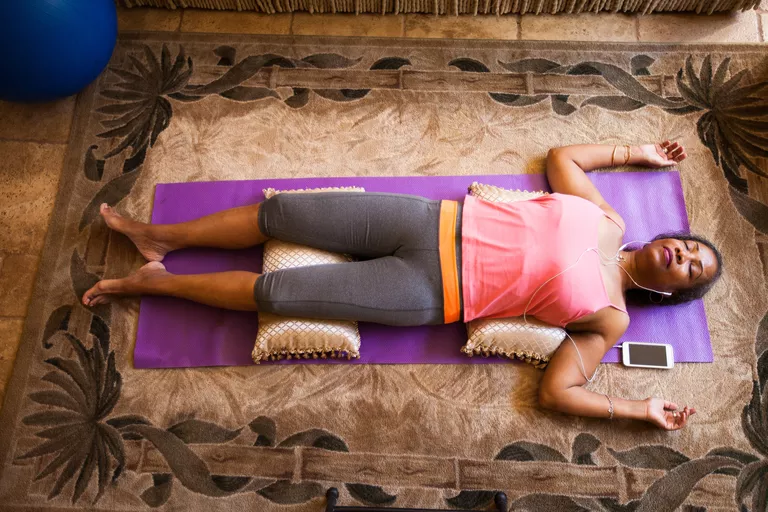Worry and anxiety affect all of us, especially during times of worry and pressure. In fact, tens of millions of people suffer from anxiety. It is one of the most common mental health issues in the world. So if you experience it, know you are not alone. If you continually suffer from it, know too, that you are not alone. Anxiety makes people feel tense and worried. At times, for no particular reason at all. Some people may just worry over the fear of returning anxiety. It evokes emotions that make you feel agitated and distressed. It is felt in the mind, but is also felt in the body.
Anxiety is caused by our biology and our genetic predisposition, as well as our views, coping mechanisms and stress. It’s often a response to future concerns, and the manifesting worry of the upcoming events of our lives. However, people don’t necessarily need to have awareness of an exact cause to experience it; the mind can become anxious even without an identifiable fear. Fortunately, mindfulness and meditation have been proven to be extremely effective in terms of managing anxiety.
The first exercise we will explore is called Body Scanning. Body scanning is a successful meditation practice that helps a person explore the value of being present and to learn how to handle anxiety in a more rational way. It will teach you to soften our reactivity and will lean you into techniques like ‘noting’and ‘pausing.’ You must also explore the nature of change, and how to befriend anxiety by understanding your body’s needs rather than hiding and running from your anxiety. It will also help your mind and body focus and connect with the present moment. This is useful in times of anxiety because when we are focused on the here and now, we aren’t fixating on past and future concerns. Focusing on the present moment offers your mind a break of being preoccupied and reacting to the content of our minds. It also offers you a chance to step away from the spiral of worry to observe what’s happening with a calmer mind.
You will begin by taking a comfortable position. Straighten your back nice and tall. Take a posture that will allow the breath to flow easily without much constriction. Rest your hands effortlessly on your lap, and when you’re ready, close your eyes.
Sit in an upright position. Keep your back straight, and keep your eyes closed. Let the world around you dim down, without worrying about the curtain that you will sit behind quietly for a few moments. Take a few long deep breaths. Let any thoughts or worries fade into the background and allow the full length of your body to relax. With each breath you take, begin to feel more and more at ease. Feel the tension of your jaw, shoulders, and stomach drop. Soften the breath and exhale very slowly; returning your breathing to a natural rhythm. Follow the movement of each breath as it draws in an out. Observe each inhale and each exhale while it connects you to this very moment.
Now, shift your attention to the body, scan it from head to toe. Let’s start with the top of your head. Not looking at anything in particular, just noticing sensation. Bring your awareness to your face, soften the eyes, allow them to drop and relax naturally. Relax the forehead and the jaw. You might even notice sensations in the inside of your mouth and lips. If you don’t, that’s okay as well. Continue listening and paying attention to just your body. Extend your focus to your neck, and focus on the back of your throat. Continue breathing naturally. If you find yourself once again drowning into your thoughts, it’s okay. The brain is used to this. It is not used to calamity and relaxing without worrying. Simply bring your attention back to your body. Bring your attention to the shoulder, notice any tension or tightness and allow it to soften, if possible. Focus on the sensations you are feeling and use your breath to connect you into the present moment.
Then notice any sensations in the arms, there may be tingling, pulsing heat or coolness. You may not notice any sensations at all. Just accept whatever your present moment experiences. Then extend your awareness down the arms, towards the wrist, hands and fingers. Use the breath to sharpen your focus on all the sensation here. See if you can feel an openness in your chest now. Notice the lung extending and opening, fill it up with air. Hold for a few seconds. Now drop your focus and slowly empty your abdomen of air. If your brain wanders, gently bring it back to the sensation of your body. Do not judge or be too hard on yourself. This is only natural. It takes time for your brain to accept sitting in a position and not reacting. Bring your attention to your stomach, it is very common to hold emotion here, so do not be surprised if you currently feel or have felt a tightness or uncomfortably in your stomach. If so, see if extending your breath softens the tension in your stomach.
Now bring your awareness to the length of your back. Not judging anything in your experience, just simply note anything that you feel. Focus on the sensation and only the sensation. Bring your awareness to your pelvis. Focus on any fabric of support ( I.E a mattress or chair you are sitting on) and drop your attention to the length of your legs. Bring your attention to each detail. Direct your awareness down your thighs, into the knees, the calves, chins, ankles, feet and toes. Continue being open to everything in your present experience. Observe the weight of your body. Explore the temperature in the room. Pay attention to any sounds around you and connect to everything in this very moment.
Now, notice how it feels to rest your mind in present moment awareness. When we focus our attention on the breath or the body, we offer our minds a chance to slow down and respond with softer reactivity. We offer our minds the chance not to quickly react to the content of our thoughts. That’s part of why mindfulness is so useful in elevating anxiety. It is also very sufficient in teaching how to remain patient in any area of your life; to sit and listen to your surroundings without feeling the need to promptly react. If you practice mindfulness 15-20 minutes a day, you will find significant changes in how your body and mind will handle stress and anxiety.
As you come to the end of the session, you will bring your attention back to the room. Wiggle your fingers and toes gently, and when you’re ready, open your eyes. You’ll have completed your first mindfulness exercise of both managing and calming your anxiety and, with practice, you will realize that you will gain benefits of greater self-control, affect tolerance, improved concentration, mental and emotional clarity and the ability to treat yourself, and others, with kindness.







Comments (0)